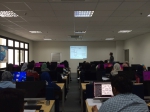Ionic Liquid, a New Breakthrough for Safer Smartphone Battery Material
By Adi Permana
Editor Adi Permana

BANDUNG, itb.ac.id – Have you ever heard about the news of an exploded cell phone battery? That accident, which happened chemically, was explained in the Institute for Research and Community Services Institut Teknologi Bandung (LPPM-ITB) Webinar Series, on Wednesday (23/2/2022). The webinar was presented by Kiki Adi Kurnia, Ph.D., a non-permanent lecturer researcher at the Faculty of Industrial Technology ITB. The title of the webinar was "Ionic Liquids – Designer Solvents for Green Chemistry".
Before he began explaining why a smartphone battery can explode, Kiki first spoke about a specific profession in the field of chemistry, Molecular Designer. "A molecular designer's job is to align chemical compounds so that they produce specific characteristics and functions," said Kiki.
Kiki is a molecular designer. He worked on the electrolyte compounds that are used inside the battery of a smartphone. A possible reaction that is caused by those electrolyte compounds is temperature increase, and on an extreme level, it could lead to an explosion. This accident often happens when the smartphone is stored in a place with high temperatures, such as inside a car.
"Finding the solution to prevent this accident from happening again is a job for a molecular designer," explained Kiki.
Inside the battery, electrolytes are used to separate the cathode from the anode. "The battery explosion accidents happen when the cellphone is used for a long duration in which it is experiencing an overheat, or when it is stored in a high-temperature environment. Those two conditions can cause the electrolytes inside the battery to dry and evaporate. Dry electrolytes cause the anode and cathode poles to move closer. When those two poles finally meet, an explosion will happen," said Kiki.
Therefore, Kiki's research was to design safer and less explosion-prone electrolytes. "One of the compounds that I used was ionic liquid. Ionic liquid has a higher thermal conductivity, thus making it less volatile and flammable," concluded Kiki. Furthermore, he also said that there is multiple research that shows ionic liquid can increase battery efficiency. Ionic liquid also has a high melting point of 700 to 800 degrees Celsius.
The design process of ionic liquid also involves experimenting with its melting point. As an example, NaCl is altered to have a lower melting point by replacing the chloride (Cl) with bromine (Br), thus producing NaBr with a 700 degrees Celsius melting point. Another example is the process of combining multiple ions, such as butyl-3-methylimidazolium. The size of those ions is very large and can weaken the ionic bonds between the anion and cation. When the bonds become weak, the melting point will decrease drastically. Some ions can even reach a melting point as low as room temperature. "This can be beneficial because we don't have to work with such high temperatures,” explained Kiki.
The challenge when designing an ionic liquid is the complex structures of its cation, anion, functional group, and side bond. The abundance of those structures will take a lot of time to analyze. "However, through a computational approach, research that previously could have taken up to 10 years can be accelerated and streamlined to only take 2 days," said Kiki.
Moreover, Kiki said that he is also conducting another research to design ionic liquid as a solvent for methane gas products. "In nature, methane gas is co-existing with CO2. However, in the methane gas production, the CO2 needs to be separated by using alkanolamine, an ionic liquid" explained Kiki. Ionic liquids are also very beneficial in the extraction process of natural resources, such as by acting as an antioxidant.
"Through this research, a conclusion that we obtained is that ionic liquids are proven as safe, non-corrosive chemicals, and can also increase the production efficiency," explained Kiki.
Reporter: Yoel Enrico Meiliano (Food Engineering, 2020)
Translator: Favian Aldilla Rachmadi (Civil Engineering, 2019)
Photo source: freepik

.jpg)
.jpg)
.jpg)
.jpg)
.jpg)



